

Flexible graphene transistor sets new records. Researchers at the University of Texas at Austin in the US say that they have made state-of-the-art flexible graphene field-effect transistors with record current densities and the highest power and conversion gain ever. The transistors also show near-symmetric electron and hole transport, are the most mechanically robust flexible graphene devices fabricated to date, and can be immersed in a liquid without any ill effects. Graphene is a single, flat sheet of carbon arranged in a honeycombed lattice. It has many unique electronic and mechanical properties, such as extremely high carrier mobility – which means that it is an ideal material for use in ultrafast transistors. Graphene logic for the real world. Researchers make single-atom transistor. Researchers in Australia have created a single-atom transistor by planting an individual phosphorus dopant atom within a silicon sample with a spatial accuracy of plus or minus one lattice spacing.
The research builds on earlier work by the same group allowing the creation of atomic-scale electrodes. While the transistor may currently help toward the continued miniaturization of classical electronics, the researchers hope that in the future their device will help develop a functional quantum computer. Moore's Law. Introducing the 'nano-ear' Physicists in Germany have developed the first-ever "nano-ear" capable of detecting sound on microscopic length scales with an estimated sensitivity that is six orders of magnitude below the threshold of human hearing.
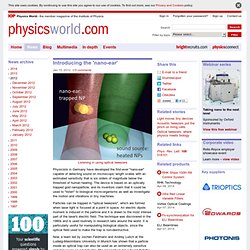
The device is based on an optically trapped gold nanoparticle, and its inventors claim that it could be used to "listen" to biological micro-organisms as well as investigate the motion and vibrations in tiny machines. Particles can be trapped in "optical tweezers", which are formed when laser light is focused at a point in space. An electric dipole moment is induced in the particle and it is drawn to the most intense part of the laser's electric field.
Bulging fibre excels at storing light. A tiny resonator that can store light without significant losses has been created by researchers in the US.
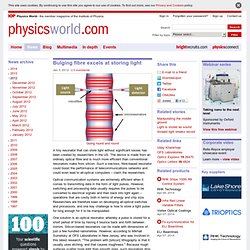
The device is made from an ordinary optical fibre and is much more efficient than conventional resonators make from silicon. Such a low-loss, fibre-based resonator could boost the performance of telecommunications networks and could even lead to all-optical computers – claim the researchers. Optical communication systems are extremely efficient when it comes to transmitting data in the form of light pulses. However, switching and processing data usually requires the pulses to be converted to electrical signals and then back into light again – operations that are costly both in terms of energy and chip size. Researchers are therefore keen on developing all-optical switches and processors, and one key challenge is how to store a light pulse for long enough for it to be manipulated. Tugging with precision. Ohm's law holds down to atomic scale. A new technique for embedding atomic-scale wires within crystals of silicon has revealed that Ohm's law can hold true for wires just four atoms thick and one atom tall.
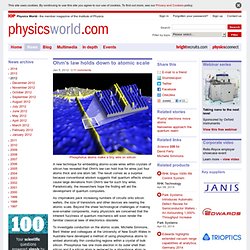
The result comes as a surprise because conventional wisdom suggests that quantum effects should cause large deviations from Ohm's law for such tiny wires. How to turn darkness into light. Quantum mechanics tells us that the vacuum is not empty but is filled with virtual particles that pop into and out of existence.

Normally these particles are hidden from our view, but now a team of physicists has used the electrical equivalent of an ultrafast mirror to convert virtual photons into real electromagnetic radiation. Known as the dynamical Casimir effect, it was first predicted more than 40 years ago. The static Casimir effect, put forward by Dutch physicist Hendrik Casimir in 1948, involves two perfectly reflecting parallel mirrors that, when placed in a vacuum, will be attracted to one another.
Three electrons for the price of one. Researchers have created a new material that can produce three or more free electrons every time it absorbs a single photon.
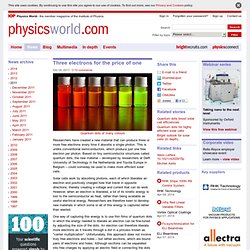
This is unlike conventional semiconductors, which produce just one free electron per photon. Based on tiny semiconductor structures called quantum dots, the new material – developed by researchers at Delft University of Technology in the Netherlands and Toyota Europe in Belgium – could someday be used to make more efficient solar cells.
Solar cells work by absorbing photons, each of which liberates an electron and positively charged hole that travel in opposite directions, thereby creating a voltage and current that can do work. However, when an electron is liberated, a lot of its kinetic energy is lost to the semiconductor as heat, rather than being available as useful electrical energy. Researchers are therefore keen to develop new materials in which some or all of this energy is captured rather than wasted. Stable, yet conducting. New 'light transistor' for optical circuits. A gadget that boosts a laser signal by a factor of 60 - based on the transfer of photons rather than electrons - could seed a new generation of ultrafast components for optical circuits.

Junji Tominaga of the National Institute of Advanced Industrial Science in Japan and colleagues developed the device, which paves the way for all-optical circuits that transmit information at - literally - the speed of light. (J Tominaga et al 2001 Appl. Phys. Lett. 78 2417). The new 'photonic transistor' would be just nanometres thick, unlike existing devices that rely on long optical fibres to produce the gain. Optical signals in conventional optoelectronic devices have to be converted into electronic signals when they are amplified or manipulated. Nanoantenna separates light of different colours.
Researchers in Sweden have invented a tiny antenna that can direct red and blue light in opposite directions.
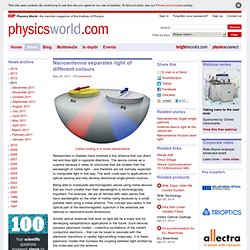
The device comes as a surprise because it relies on structures that are smaller than the wavelength of visible light – and therefore are not normally expected to manipulate light in this way. The work could lead to applications in optical sensing and help develop directional single-photon sources. Being able to manipulate electromagnetic waves using metal devices that are much smaller than their wavelengths is technologically important. Electrons surf between qubits.
Two independent groups of physicists have taken an important step towards the creation of a practical quantum computer by showing how to transfer single electrons over relatively long distances between quantum dots.

Both schemes involve using sound waves on the surface of a material to propel electrons between the quantum dots – which are sub-micron-sized pieces of semiconductor. The teams are confident that they will soon be able to show that electrons arrive at their destination with their quantum information intact, making the system a viable "quantum data bus" for a quantum computer. Quantum computers, which exploit purely quantum phenomena such as superposition and entanglement, should in principle be able to outperform classical computers at certain tasks. But building a practical quantum computer remains a challenge because the physical entities that store and transfer quantum bits (qubits) of information are tricky to implement and are easily destroyed.
Avoiding decoherence. Graphene tunes in to terahertz radiation. Graphene responds strongly to light at terahertz frequencies and this could be fine-tuned to make practical devices.

Physicists in tune with neurons. Have you ever wondered why certain sets of musical notes sound perfectly melodious while others make you want to cover your ears?
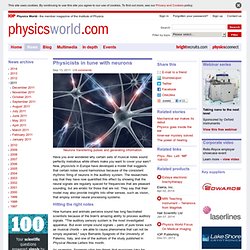
Now, physicists in Europe have developed a model that suggests that certain notes sound harmonious because of the consistent rhythmic firing of neurons in the auditory system. The researchers say that they have now quantified this effect by showing that the neural signals are regularly spaced for frequencies that are pleasant sounding, but are erratic for those that are not. They say that their model may also provide insights into other senses, such as vision, that employ similar neural processing systems.
Hitting the right notes How humans and animals perceive sound has long fascinated scientists because of the brain's amazing ability to process auditory signals. As examples, Spagnolo cites two things that musicians take for granted: the "pitch perception" and the "perception of consonance and dissonance". On board the "spike trains" Senses and sensibility. Black holes act as galactic thermostats. The supermassive black hole at the centre of a massive galaxy or galaxy cluster acts as a furnace, pumping heat into its surroundings. But astronomers have struggled to understand how a steady temperature is maintained throughout the whole galaxy when the black hole only appears to interact with nearby gas.
Now, researchers in Canada and Australia believe the answer could be a feedback loop in which gravity causes gas to accumulate around the black hole until its density reaches a tipping point. Calcium ions simulate the quantum world. The first digital "quantum simulator" based on trapped ions has been built by physicists in Austria.
The system, developed by Ben Lanyon and colleagues at the University of Innsbruck, comprises a number of trapped calcium ions that are manipulated using sequences of laser pulses. The team has used the system to simulate the time-evolution of several multi-particle systems. A quantum simulator uses one quantum system to simulate the behaviour of another, less accessible system. For example, by carefully manipulating the laser light and magnetic fields trapping an ensemble of ultracold atoms, researchers can control the interactions between atoms – and therefore simulate interactions that occur between electrons in solids. But unlike electrons in solids, the strength of these interactions can be easily adjusted, allowing physicists to test theories of condensed-matter physics.
Analogue to digital Easily scalable. Introducing the 'antimagnet' Plasmonic metamaterials could make 'gecko toes' A material that promises to stick to smooth surfaces and then release on demand has been designed by scientists in the UK. Light propagates as if 'space is missing' Flipping spins, one proton at a time.